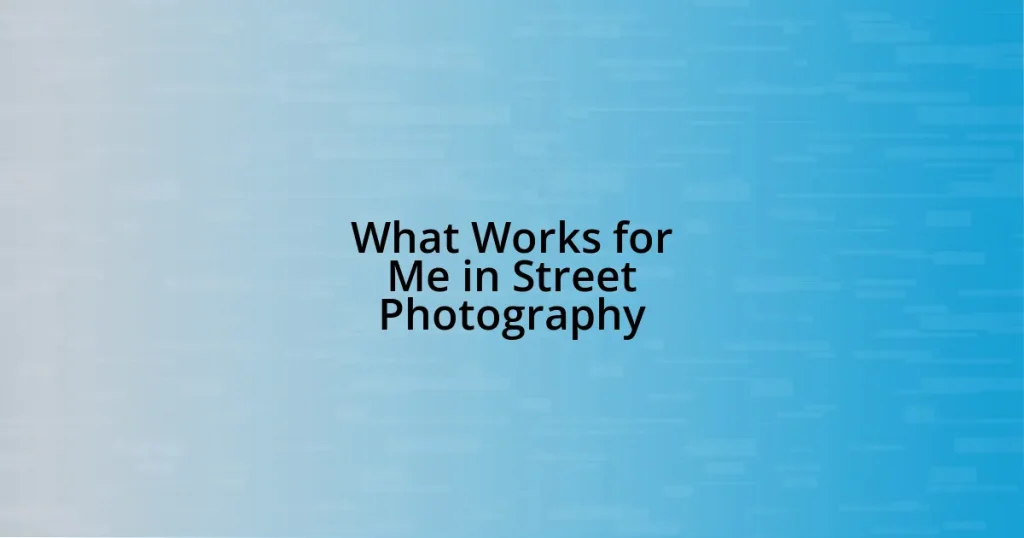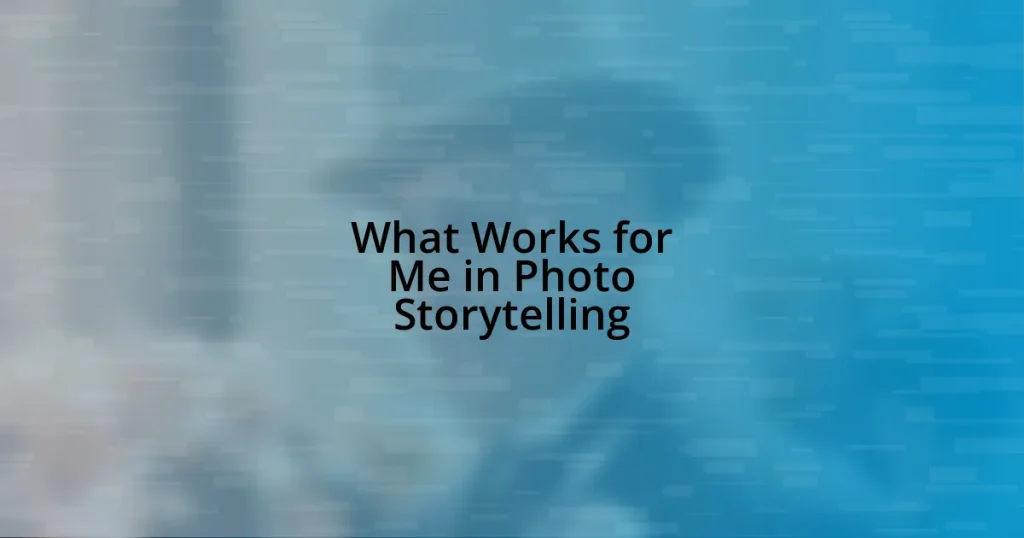Key takeaways:
- Street photography captures candid moments, fostering observation and empathy towards strangers.
- Approaching strangers enhances personal growth and leads to unexpected connections and friendships.
- Understanding body language and engaging in conversation helps build trust and authenticity in photography.
- Reflecting on personal experiences enriches the photographer’s perspective and understanding of humanity.

What is street photography
Street photography is an artistic form that captures candid moments in public spaces, reflecting the unscripted nature of everyday life. I recall the first time I pointed my camera at a stranger; my heart raced as I tried to frame the moment without invading their space. Isn’t it fascinating how a simple snapshot can tell a story that resonates with people?
At its core, street photography is about observation and connection. When I’m out in the city, I often find myself drawn to gestures or expressions that reveal deeper emotions—a fleeting smile or a glance that tells a myriad of stories. How often do we walk past strangers without wondering where they come from or what they’re thinking?
Moreover, street photography blurs the lines between the photographer and the subject, creating an unspoken bond. I once captured a woman lost in thought on a park bench; the vulnerability in her demeanor struck me deeply. Was she contemplating life, or simply passing the time? This moment taught me that each photograph can be a bridge to understanding the human experience.

Benefits of photographing strangers
Photographing strangers offers an incredible opportunity for personal growth. I remember a rainy afternoon when I approached a man waiting for a bus. Initially, I felt a wave of hesitation wash over me, but asking if I could take his portrait opened a door to a conversation that brightened both our spirits. From this experience, I learned that breaking through the barrier of shyness can lead to unexpected friendships and a richer understanding of the world around me.
Another benefit is the diverse perspectives gained through interaction. I recall being intrigued by a street musician’s performance and capturing his energy through my lens. After snapping a few photos, I learned about his passion for music and how it shaped his life. Each stranger has a story that adds depth to our understanding of humanity, and as I photograph them, I can become a vessel for these narratives.
Lastly, the act of photographing strangers fosters empathy. Every time I click the shutter, I’m reminded that behind each face lies a multitude of experiences. Once, I captured an elderly woman feeding pigeons, her gentle smile revealing glimpses of her life’s joys and sorrows. This connection—however brief—enriches my heart and my art, reminding me that we’re all woven into the fabric of society.
| Benefit | Description |
|---|---|
| Personal Growth | Courage to approach strangers leads to newfound friendships and self-confidence. |
| Diverse Perspectives | Engaging with subjects reveals their stories, broadening the photographer’s worldview. |
| Empathy | Each photograph deepens understanding of human experiences and emotions. |

Tips for approaching strangers
When it comes to approaching strangers for photography, I’ve found that a warm smile and genuine curiosity go a long way. One afternoon, while exploring a bustling street market, I noticed a woman carefully selecting fruits. Instead of immediately asking for a photo, I complimented her choices and struck up a light conversation about her favorite fruits. This natural interaction made her more comfortable with my camera, and what emerged was a radiant portrait filled with laughter and warmth.
Here are some tips that have truly helped me connect with strangers:
- Be approachable: Maintain open body language and a friendly expression to invite interaction.
- Start with small talk: A simple compliment or question can break the ice and lead to a more meaningful engagement.
- Respect their space: Always be mindful of the person’s comfort zone; if they seem uninterested, gracefully step back.
- Offer context: Explain your intent and how you plan to use the photo, which fosters trust and understanding.
- Be ready to listen: Sometimes, a stranger might share their story or insights; listening can transform the experience for both of you.
The moments captured in this way often mean more than just the images themselves; they become a testament to the human connections we can forge through a simple lens.

Techniques for capturing candid moments
Capturing candid moments requires a blend of patience and keen observation. I often find that the best moments happen when you’re not actively looking for them. For instance, during one of my trips to a park, I noticed a child chasing after a butterfly. I held my breath, silently positioning my camera to catch the joy of that fleeting moment. The excitement on the child’s face, the fluttering wings—everything fell into place, and I felt like I had frozen a tiny slice of happiness in time.
To really nail those spontaneous shots, I’ve learned to stay in the background and let life unfold naturally. One time, while sitting at a café, I saw two friends deep in laughter over shared memories. Instead of intruding, I simply adjusted my lens and waited, feeling the warmth of their friendship radiate. When I clicked the shutter, it felt as though I had been granted the privilege to witness a private joy. Don’t you agree that there’s something beautiful about capturing emotions without interruption?
Timing is everything. I often try to anticipate actions or reactions based on body language or the environment. For example, I once spotted an elderly couple strolling hand in hand, their smiles reflecting years of shared love. I quickly adjusted my settings, waited for them to pause at a picturesque spot, and captured a moment infused with tenderness. It’s moments like these that remind me that photography isn’t just about the click; it’s about being attuned to the rhythm of life around us.

Understanding body language in photography
When it comes to understanding body language in photography, I find it truly fascinating how much a person’s posture can communicate even before a word is spoken. For instance, I remember photographing a street musician who was initially hunched over her guitar, seemingly lost in her own world. But as she began to strum a lively tune, her posture transformed—her shoulders relaxed, and she started to sway. That shift not only provided me with a more expressive shot but also reinforced the idea that body language can convey emotions far more powerfully than any facial expression alone.
I’ve noticed that certain gestures can reveal so much about a person’s comfort level. During a bustling festival, I approached a group of friends, and one individual stood slightly apart, arms crossed tightly against his chest. It was clear he wasn’t entirely at ease with the idea of being photographed. Instead of pushing him into the frame, I decided to engage the group in a fun game of spontaneous questions. By sharing laughs and inviting him into the conversation, I gradually saw his body language shift. Eventually, he relaxed and even struck a playful pose, making the shot far more authentic and enjoyable.
Reflecting on these interactions, I often ponder: how can a simple adjustment in body language turn an awkward encounter into a beautiful moment? One memorable day, while walking through a downtown art fair, I approached an artist who was intently working on her canvas. At first, her body language was reserved—I could sense her focus was more on her craft than on any potential interaction. But after complimenting the vibrant colors she was using, her whole stance changed. She opened up, her arms gesturing animatedly as she told me her story, and I could capture not just her image but also the passion that enveloped her work. Moments like these remind me to read between the lines of body language and find the stories waiting to be told.

Building confidence while photographing
Building confidence while photographing can be a gradual yet rewarding journey. I distinctly remember my first attempts at capturing strangers; my heart raced, and I often felt shy or intrusive. One day, I spotted a woman laughing with her friends at a market. Instead of hesitating, I took a deep breath and asked if I could capture them. The moment I clicked the shutter, a wave of exhilaration washed over me. It was liberating to receive their smiles in return, transforming my own nervousness into a sense of connection.
As I progressed, I learned that preparation boosts confidence. Before heading out, I started practicing my camera settings at home. Familiarizing myself with my gear made a huge difference. One afternoon, armed with a newfound sense of readiness, I ventured into a bustling downtown area. With each click, I became more in tune with my surroundings. I remember capturing street performers mid-act, and the joy of freezing those lively expressions reinforced my belief that I could honor their moments through my lens.
Interestingly, engaging with my subjects has become a vital part of my process. I often ask people if I can take their photo, which leads to delightful conversations. For example, while photographing a skateboarder, I found myself immersed in his passion as he ramped up tricks. His enthusiasm sparked something in me; I felt energized and confident simply by sharing that moment. Isn’t it fascinating how confidence can grow through connection? Now, whenever I approach someone with my camera, I carry that energy with me, ready to capture not just an image but the spirit of each story waiting to be told.

Reflecting on personal growth experiences
Reflecting on personal growth experiences, I often think about the moments that pushed me beyond my comfort zone. One sunny afternoon, I decided to step into a local park with my camera, determined to document the liveliness of a community gathering. As I approached a group enjoying a picnic, I felt the familiar flutter of anxiety. But instead of shying away, I introduced myself and shared my intent. It was remarkable how quickly their initial wariness melted into warmth. This taught me that vulnerability can pave the way for connections, allowing both the photographer and subject to share a piece of their world.
I find that each interaction shapes my perspective, deepening my understanding of humanity. For instance, I vividly recall photographing an elderly gentleman sitting on a bench, seemingly lost in thought. Approaching him hesitantly, I simply asked what he was reflecting on. When he opened up about his life experiences, it felt like I was privy to an intimate story that enriched both his image and my soul. It left me wondering: how often do we overlook the beauty in the stories strangers carry with them? This experience reinforced my belief that we should never assume a stranger’s silence equates to disinterest; sometimes, it just takes one question to unlock a treasure trove of experiences.
Moreover, I’ve realized that reflecting on these experiences encourages ongoing self-discovery. I often look back at my photographs and think of the laughter, stories, and connections captured in that moment. It’s almost like a scrapbook of my growth—each image a reminder of the lessons learned along the way. It leads me to ask: what other journeys await not just in photography, but in life? This sense of curiosity keeps me moving forward, eager to embrace new encounters and let them shape the person I continue to become.
















